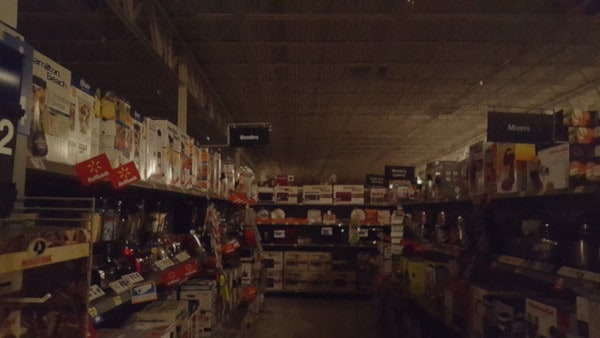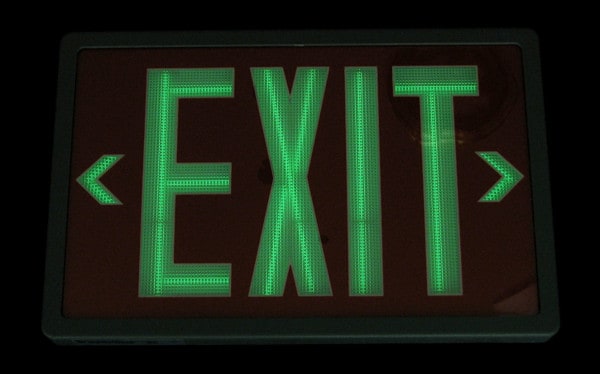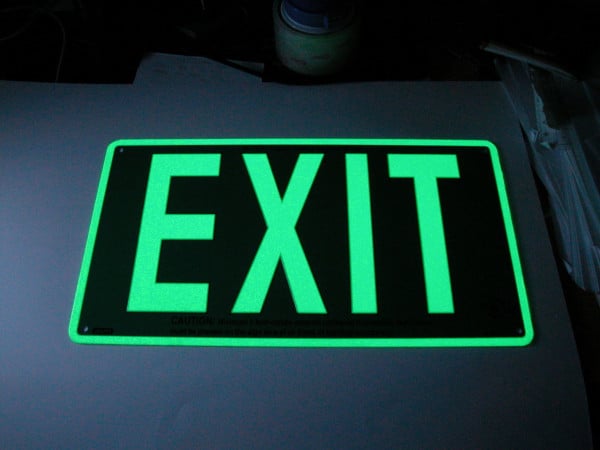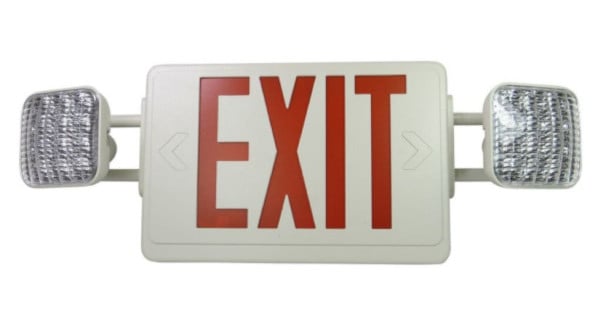Batteries, bulbs, and other important features essential for crisis-ready emergency lights and exit signs
Commercial, industrial, and large residential buildings of all kinds require exit signs and emergency lights. But while they’re almost always in sight, many facilities managers fail to notice when they stop working, leaving a building’s occupants in the dark when trouble arises.
This article discusses how to prevent exit signs and emergency lights from failing—and why it matters. We explain why non-electric exit signs aren’t a viable alternative to signs with a battery backup (even though they sometimes claim to be) and cover how careful selection and testing of electric fixtures can prevent problems.
If you’d prefer, browse our selection of exit signs, emergency lights, and emergency light combos.
People rely on exit signs and emergency lights surprisingly often, but facilities managers often fail to ensure that they work
Power outages in the United States quadrupled between 2000 and 2014. Increasing demand for electricity is straining an aging electrical infrastructure—particularly in the summer months—while a rising number of severe storms continues to leave people in the dark. A 2017 Michigan storm with wind gusts in excess of 60 miles per hour, for example, downed thousands of power lines and caused more than a million homes and businesses to lose power for days—and some for as long as a week.

To prevent these and other emergency situations from becoming more chaotic or hazardous, many state and local governments adopt model codes written by the National Fire Protection Association (NFPA). The standards contained in NFPA 101: Life Safety Code require easy-to-see signs at nearly all exits and lighting along exit routes. These emergency lights and exit signs must provide a minimum level of illumination for no less than 90 minutes during a power failure.
These problems should be uncovered and documented during the monthly tests required by NFPA 101 in section 7.9.3. But more than half all facilities may not monitor or maintain their emergency lighting, and failures of emergency lights and exit signs are among some of the most common code violations businesses face.
Self-illuminated alternatives to electric signs offer longevity at a steep price—and may require electricity anyway
Some facilities managers may try to eliminate power failures by forgoing electric signs entirely. While that option isn’t available for emergency lighting, some manufacturers do offer self-illuminated exit signs—either of the tritium or photoluminescent variety—that glow without an electrical power source.
Some of these exit signs are illuminated by the radioactive gas tritium. Sealed tubes with a light-emitting compound keep the tritium in place and give this colorless gas a red or green glow. While these devices are designed to be safe, damage to a tritium exit sign can contaminate the surrounding area, resulting in cleanup costs that sometimes exceed $100,000. Exhausted signs cannot be thrown away with other garbage and must be carefully disposed of by a broker or other licensed company at a cost of around $125 to $150 for a single sign face. While these signs are sometimes suitable when electrical power is inaccessible, disposal requirements and the financial risk involved make them undesirable in most applications.

Facilities managers unwilling to take a chance on tritium may find a tempting—but ultimately disappointing—alternative in photoluminescent exit signs. Like other glow-in-the-dark products, photoluminescent exit signs feature chemicals that absorb energy from a light source and re-release it as visible light.

While these and other self-luminescent exit signs are permitted by NFPA 101, they require constant illumination from an external energy source while the building is occupied, undermining their energy savings. Further, many of these signs have been found to emit only a small fraction of the minimum brightness required to be listed as an NFPA-compliant internally-illuminated sign. And those signs can lose up to 80% of that luminance in only ten minutes, falling far short of the 90-minute illumination requirement when the power cuts out.
For electric emergency fixtures, backup battery types offer tradeoffs in durability, power, and more
While self-luminescent signs are an option, most buildings have exit signs and emergency lights that rely on an electric power source.
Their backup batteries store electrical energy in a chemical form and convert that energy to electricity as needed. All batteries have three parts: a positively-charged anode, a negatively-charged cathode, and an electrolyte that allows an electrical charge to move between them. When a wire connects the anode and the cathode, it creates a circuit that permits electricity to pass through the battery and power the devices connected to it. This process changes the chemical makeup of the battery until the anode and the cathode are no longer charged. At this point, the battery has no energy left to give.
Rechargeable batteries can reverse this reaction to restore the battery’s charge, but these chemical changes eventually become irreversible, leaving the battery unable to charge. Per NFPA, all backup batteries in emergency lights must be rechargeable:
From the 2018 edition of NFPA 101
7.9.2.6 Existing battery-operated emergency lights shall use only reliable types of rechargeable batteries provided with suitable facilities for maintaining them in properly charged condition. Batteries used in such lights or units shall be approved for their intended use and shall comply with NFPA 70.
Emergency lights and exit signs typically rely on one of two battery types for backup illumination: sealed lead-acid (SLA) batteries and nickel-cadmium (NiCad or NiCd) batteries. Sealed lead-acid batteries create their charge with lead, lead oxide, and an acid that breaks them down to produce an electrical charge. Nickel-cadmium batteries rely on positively-charged nickel oxide and a negatively-charged cadmium compound along with an electrolyte made from potassium hydroxide.
The design of sealed lead-acid batteries allows them to cost less, store more electricity, and do a better job withstanding damage caused by overcharging. Their ability to deliver more power makes them a likely choice for emergency lights, exit sign/light combinations, and industrial lighting applications where more brightness is required.
However, rechargeable sealed lead-acid batteries can be damaged by “deep cycling.” Fully discharging the battery (aka running it to empty) makes it discharge up to twice as much energy as its rated capacity, causing the battery to permanently lose capacity and creating tiny short circuits. To prevent this from occurring, some manufacturers offer fixtures with a low-voltage disconnect (LVD) feature that stops the battery from fully discharging.
NiCd batteries generally have a longer life, faster charge times, and a wider temperature range than sealed lead acid batteries. Some manufacturers estimate that these batteries can be used for as long as nine years before replacement—with no maintenance required. However, nickel-cadmium batteries can lose their capacity and life when exposed to especially hot or sub-freezing temperatures. In parking garages, warehouses, and other facilities with low temperatures, these fixtures may last longer when equipped with an internal heater designed to keep the battery and other components warmer.
LED lamps can keep an emergency light or exit sign running for far longer than other bulb types
While backup batteries are rarely used and can quietly fail, lamps—particularly on exit signs—may receive a great deal of use, impacting both longevity and operating costs. Emergency lights use one of three lamp types:
- Incandescent
- Fluorescent or compact fluorescent lighting (CFL)
- Light-emitting diodes (LED)
Each of these lamp types creates light in a different way. Incandescent lightbulbs heat a wire or thread known as a filament until it glows. Fluorescent lamps and CFLs use electricity to create a chemical reaction between different types of gasses. In turn, these gases produce invisible UV rays that cause the phosphor-coated bulb or tube to glow. LED lamps use semiconductors—materials that conduct electricity, but not as well as metal—that emit light as electricity passes through them.
LEDs are efficient by design. While incandescent and fluorescent bulbs emit light and heat in all directions—and expend much of their energy creating heat—LEDs emit light in a specific direction and lack the delicate components that make other lightbulbs wear out quickly.

LED bulbs have substantially longer lives and lower energy requirements than other lamp types, making them a popular choice in exit signs and emergency lights. Some emergency fixtures have LED bulbs with a typical life of ten years—running continuously. Fluorescent or incandescent lights cost more to run and last a fraction of that time, with fluorescent lights having a service life of fewer than 11 months and incandescent lights lasting less than three months. However, LED lamps do slowly lose the ability to give off light over time. Officially, an LED’s lamp life ends when the LED has undergone a 30 percent decline in light output.
Self-testing fixtures can make required monthly and yearly tests easier
The National Fire Protection Association requires monthly and annual tests for both emergency lights and exit signs. These simple tests take less than a minute per fixture and confirm that batteries, lamps, and other critical components are still functioning. For emergency lights, these testing requirements are found in section 7.9.3 of NFPA 101, and these same standards are applied to exit signs in section 7.10.9.2.
From the 2018 edition of NFPA 101
7.9.3.1.1 Testing of required emergency lighting systems shall be permitted to be conducted as follows:
(1) Functional testing shall be conducted monthly, with a minimum of 3 weeks and a maximum of 5 weeks between tests, for not less than 30 seconds, except as otherwise permitted by 7.9.3.1.1(2).
(2)* The test interval shall be permitted to be extended beyond 30 days with the approval of the authority having jurisdiction.
(3) Functional testing shall be conducted annually for a minimum of 1 1∕2 hours if the emergency lighting system is battery powered.
(4) The emergency lighting equipment shall be fully operational for the duration of the tests required by 7.9.3.1.1(2) and 7.9.3.1.1(3).
(5) Written records of visual inspections and tests shall be kept by the owner for inspection by the authority having jurisdiction.
To make this testing easier, most emergency lights and exit signs have a small button used to test the bulb and the battery. Other emergency fixtures make testing even easier by performing tests—and diagnosing failures—automatically. Self-testing, self-diagnostic fixtures perform both the 30-second tests required monthly and even the extended 90-minute tests required annually. If these tests fail, these fixtures will provide a visual indication—usually with a flashing or glowing LED—that helps facilities managers diagnose and solve the problem, as shown in the video below:
Stay safe and code-compliant with emergency lights and exit signs from QRFS
If you’re looking to make the switch to an emergency fixture built to last, take a look at our selection of exit signs and emergency lights from Simkar. These American-made lights meet NFPA requirements and feature long-lasting, energy-efficient LED lamps. Each fixture comes standard with either a rechargeable sealed lead acid or NiCd battery designed to be maintenance free. All electronics and housing come with Simkar’s five-year warranty and a five-year pro-rated battery warranty.

Browse our selection of exit signs and emergency lights.
Questions? Need to order exit lights with self-testing, self-heating, or other special features? Call us at +1 (888) 361-6662 or email support@qrfs.com and we’ll take care of it for you.
This blog was originally posted at blog.qrfs.com. If this article helped you choose emergency fixtures made to last, check us out at Facebook.com/QuickResponseFireSupply or on Twitter @QuickResponseFS.



Dear Sales,
My Institution request any of the below Power Supply
We are looking to purchase Provide a wholesale price quote on any of the ITEMS
(A)Power Magnum Inverters MS4024PAE
(B)Solar panel 300watt up to 375watt, 24volt, Any
brand
(C)12V 180AH upto 275AH @ 20HR Sealed AGM Battery.Any brand
We appreciate your prompt response.
John Lang
Tel:(301)-508-9081
E-Mail:jlang@wisecomtechinc.com
John — We do not sell power-supply equipment, but we can help with electric exit signs. Best of luck on your search!
When I press the back up battery test button on some of our Duallite LXURWE EXIT signs,the green pilot light does not go out and it looks like the LEDs are still powered from the AC circuit.
Joe — you should defer to the manufacturer’s instructions or, if necessary, contact support to troubleshoot any issues. Dual-Lite products are made by Current, which is in turn owned by Hubbell. Here are the search results for Current’s Dual-Lite Exit signs; if you don’t have the manual you can find your model and download it there. Click here for their customer support contact info. Hubbell also has similar resources. Thanks for reading and best of luck!